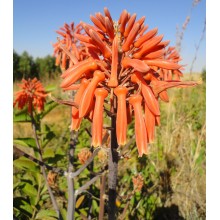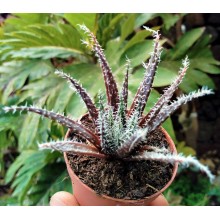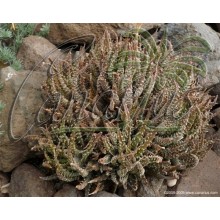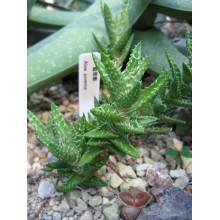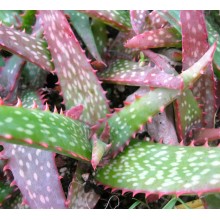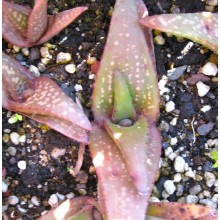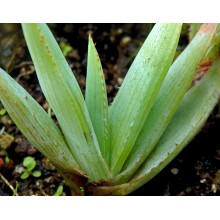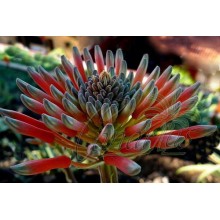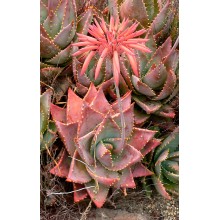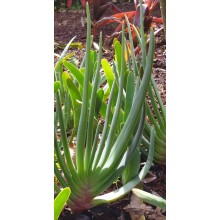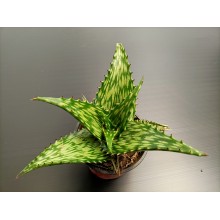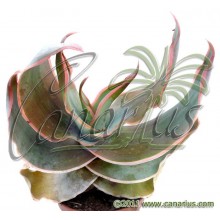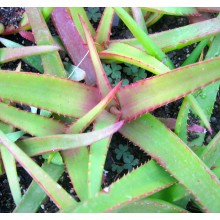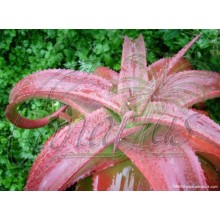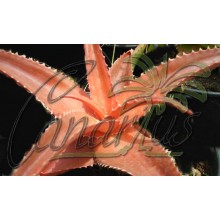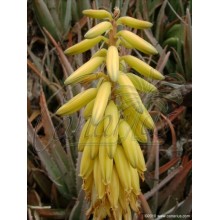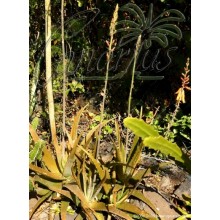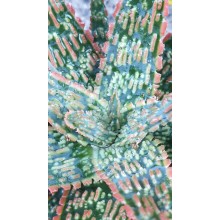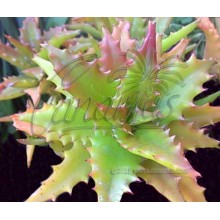Succulents There are 628 products.

World deserts and dry areas are home to the most interesting plants. Canarius offers an increasing selection of succulent plants of maximum quality, because they are grown outdoors, under the full sun of the Canary Islands.
Succulents or "fat plants" are water-retaining species, adapted to dry conditions. They store succum (juice, water) in their leaves, stems or roots, and often show a stout and fleshy appearance.
Subcategories
-
Agave
Agave is a genus of succulent plants from America. Some species grow in cold areas and take hard frost, while some others live in tropical climates. Some are tiny dwarfs and some are giants, up to 2 or 3 m wide.
Cold hardy agaves can create an exotic effect in your garden. Agave species make fine companions to palms or cacti. Variegated agaves are incredibly sought after by collectors. Our web shop offers an ever changing selection of species. We ship bare rooted plants, unless otherwise specified.
-
Aloe, Gasteria & Haworthia
Aloe, Gasteria and Haworthia are three related genera, comprising hundreds of succulent plants. They are all easily grown in pots. A few adapt to low-light levels of indoor conditions and can be grown as house plants.
- Aloe is a genus of about 400 species, native to Africa, Arabia and Madagascar. Small or dwarf aloes are becoming especially popular in colder climates as they can be taken indoors during the hardest months.
- Gasteria includes some 80 species endemic to South Africa, known for their spectacular leaves which are glossy, mottled and textured. They bloom in Spring-Summer with long spikes of small orange flowers. Some species are so variable that we offer particular clones from specific locations.
- Haworthia is a genus endemic to South Africa with about 70 species and a number of local subspecies, varieties and forms. Leaves are often banded, speckled, dotted, or semi-translucent and show wide variations.
-
Crassulaceae
This is a new, growing section of species from the family Crassulaceae. There are about 1,400 species in 33 genera and their distribution is worldwide, but mostly occur in the Northern Hemisphere and Southern Africa, especially in dry habitats. Here you can buy healthy, sun-hardened plants grown in the Canary Islands and shipped to your home.
-
Mesembs
This group of desert plants is briefly named Mesembs because they belong to a botanical family formerly named Mesembryanthemaceae. There are almost 2.000 species, mainly found in Southern Africa, with extreme adaptations to dry habitats. Some are called "living stones", as they look like pebbles. Many are easy to grow and their main need is full sun. Some are difficult because they grow in truly extreme areas.
Our Web Shop offers sun grown healthy plants, with compact and colourful leaves. Some plants are sold as cuttings, and others as rooted plants, of at least two years old.
-
Sansevieria
Recently assigned to the family Asparagaceae, the genus Sansevieria counts about 70 species, nearly all native to Africa, Arabia and Madagascar. Perennial herbs adapted to dry habitats with stiff, succulent leaves, their length ranges from a few centimeters to 2 meters. Sansevieria trifasciata and its many cultivars are among the most popular houseplants, popularly called mother in law's tongue. A well grown plant usually produces a spike of many white, richly scented flowers and then orange berries. Even the rarest species are resistant to neglect, provided you keep them from frost in winter and scorching sun in summer.
-
Hoya
Hoyas are twining vines, with showy exotic flowers, from the rainforests in Asia and Oceania. Most species grow in bright shade or morning sun, but they will also grow indoors as house plants. They are well suited for baskets, trellises or ladders. They tolerate a few weeks of drought but they are sensitive to frost and cold. Many hoyas are easy to grow and bloom, while some are tricky and rare.
-
Asclepiads
Asclepiads or Asclepiadoideae are a subfamily in the Apocynaceae, with about 2900 species. There are lots of leafless stem succulents but also perennial herbs, shrubs, lianas or rarely trees. They produce remarkable flowers, for the complex mechanisms they have developed for pollination. Many species produce an unusual fragrance, often called "carrion", and attracts flies for pollination. -
Caudiciforms
These plants from dry areas produce an unusually thick stem, the caudex. They are also called pachycauls and they have a disproportionately thick trunk, often with few branches. The caudex can be hidden underground, but in most cases they grow upwards, forming spectacular trees. The largest caudiciforms in the world are the baobabs. -
Other succulents
Here you will find all those species of desert plants that are not included in their own category. We will place here all plants from unusual families, other than Agaves, Aloes, Crassulaceae, Sansevieria, Mesembs, Epiphytic cacti, etc.
-
Aloe greatheadii var. davyana
Aloe greatheadii var. davyana
Variable South African aloe with colourful leaves, of different greens, oranges, browns and even greys. They typically show abundant "H marks".
22,50 € -
Aloe haworthioides
Aloe haworthioides
Miniature aloe from central Madagascar. It slowly forms a clump of diminute rosettes with "hairs". It is slow but forgiving in cultivation and can grow by a bright window, much like haworthias. Avoid frost, it can barely stand it!
12,20 € -
Aloe juvenna
Aloe juvenna
Cont. 8 cm. It is native to South Africa and its grows vertically and grouped.Its leaves from green spiral rosettes whith specks and small spines.
10,20 € -
Aloe labworana
Aloe labworana
Stemless aloe with yellow flowers, native to rocky outcrops in the mountains of northern Uganda and southern South Sudan between 1300 and 1500 m.
23,20 € -
Aloe lavranosii
Aloe lavranosii
Aloe lavranosii is a native of Yemen on the Arabian Peninsula. It is one of the few species of Aloe with "hairy" flowers. Plants grow usually solitary with blueish leaves.
14,20 € -
Aloe lineata
Aloe lineata
South African species with blue-green leaves marked with longitudinal red lines (hence "lineata"). It branch from the base and produces erect stems, so it eventually becomes a dome-shaped shrub, 1-2 m tall.
13,40 € -
Aloe maculata
Aloe maculata
Slowly clumping rosette,with elegant red inflorescences held on tall stalks. The dark green leaves have the typical white H spots.It is a widespread South African aloe tolerant of different conditions.
10,80 € -
Aloe perfoliata
Aloe perfoliata
Cont. 8 cm. It is native to South Africa and its characterized by prostrate, long and branching stems that isn't stend of growing upright but they tend to sprawl along the ground and over rocks.
11,70 € -
Aloe plicatilis (Kumara plicatilis)
Aloe plicatilis (Kumara plicatilis)
Thick 15-20 cm 1-y old rooted plant - It is a spectacular species, relative of the genus Aloe with leaves arranged as fans. Kumara plicatilis grows as a shrub or small tree and thrives outdoors in the coastal Mediterranean. It blooms in winter and its flowers are much larger than most aloes !
45,00 € -
Aloe plicatilis (Kumara plicatilis)-Large
Aloe plicatilis (Kumara plicatilis)-Large
Thick 26-40 cm 2-y old rooted plant - It is a spectacular species, relative of the genus Aloe with leaves arranged as fans. Kumara plicatilis grows as a shrub or small tree and thrives outdoors in the coastal Mediterranean. It blooms in winter and its flowers are much larger than most aloes !
60,60 € -
Aloe somaliensis
Aloe somaliensis
Elegant spotted aloe from Somalia. The glossy rosettes are often solitary, low growing. Colours change through the seasons, from green to grey, copper, burgundy or brown.
18,20 € -
Aloe striata
Aloe striata
Cont.= 8-12 cm - Very ornamental South African species, with a compact rosette of colourful, smooth leaves with beautiful red inflorescences.
14,30 € -
Aloe tauri
Aloe tauri
This hard to find species is very attractive due to its bright orange blush, promoted by full sun and cooler nights. It grows on the southern escarpment in Zimbabwe, at 1000-120 exposed to SE winds and mist. It is promisingly cool-resistant and it thrives outdoors in coastal mediterranean conditions.
26,50 € -
Aloe vanbalenii
Aloe vanbalenii
Very elegant, large South African Aloe with a stemless spreading rosette of colourful recurved leaves. Leaves can get a different colour according to light intensity, yellow-green to orange and eventually rusty-red in full sun. Rosettes can get up to 1 m large and slowly grow into clumps. Flower spike are also attractive, with yellow flowers.
23,10 € -
Aloe vaombe
Aloe vaombe
Impressive large and colourful Aloe from Southern Madagascar. Leaves are green during the growing season and turn red during rest. It grows outdoors in warm Mediterranean conditions but can be damaged by frost. It produces large, showy inflorescences of bright red flowers, at the start of Winter.
15,48 € 17,20 € -
Aloe vera - 1 kg Large Plant
Aloe vera - 1 kg Large Plant
Robust plant, 30-40 cm, 1 kg, field-grown in full sun. This is the famous Aloe vera, known for holding healthy properties. The tips of the tall flower spikes are edible. Leaves are green-glaucous to pink-copper. Takes light frost if kept dry.
11,80 € -
Aloe vera var. chinensis
Aloe vera var. chinensis
10 cm cutting. A different, red flowered Aloe vera. This variety is slower than the typical form and has a denser, richer sap, also used in traditional medicine.
14,20 € -
Aloe x 'Christmas Carol' - Large
Aloe x 'Christmas Carol' - Large
This hybrid Aloe is a winner! It is a great beauty, with all types of reds, green and purples displayed on stripes, dots and teeth. 'Christmas Carol' is mid-sized and can reach 30 cm in diameter and height. It was developed by Griffin, the famous hybridiser of small sized aloes.
35,00 € -
Aloe x buettneri
Aloe x buettneri
Rooted plant, 10-12 cm diam. Cont. 8 cm. We got this Aloe as A. buettneri, but it looks to us like a hybrid of Aloe dorotheae. Rosettes are 10-16 cm wide, leaves are speckled and turn glossy red during rest or in full sun. It grows as a dense groundcover and makes a nice potted specimen or even a hanging basket plant. It can stand low temperatures but it...
14,20 €
At the moment there are few products in this category Succulents

























